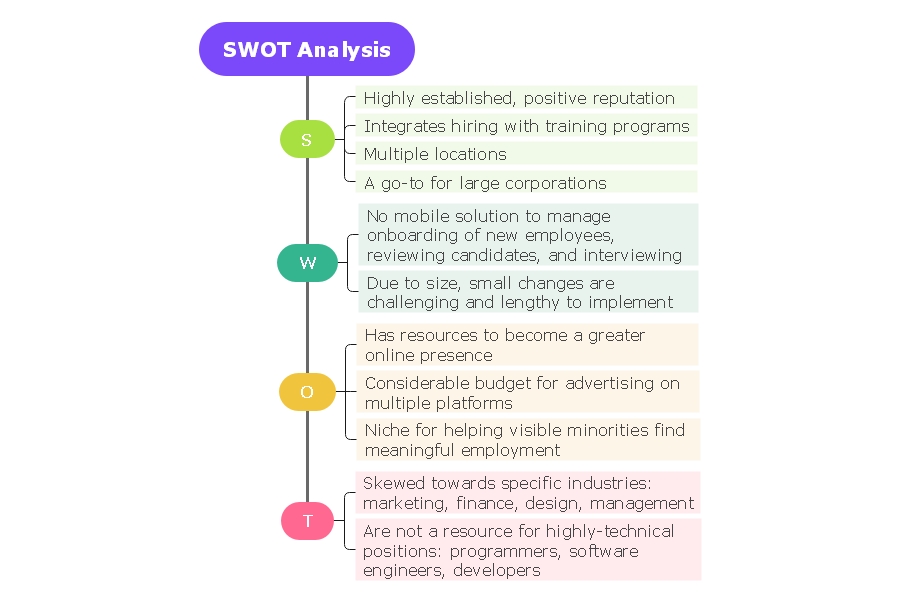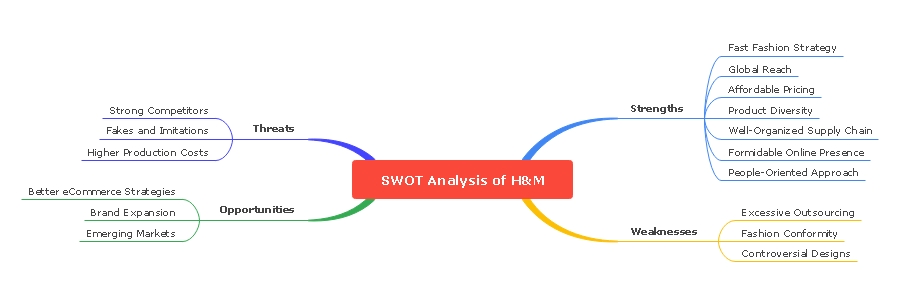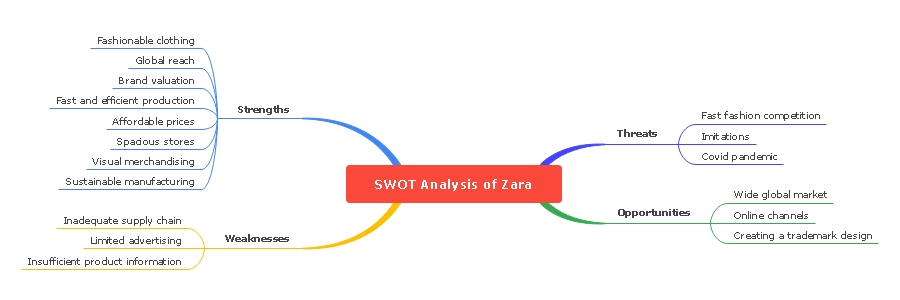SWOT Analysis: Explained with Examples & Templates
Edraw Content Team
Do You Want to Use SWOT Analysis?
EdrawMind helps move ideas forward, faster and better. Learn from this SWOT Analysis complete guide to know everything about SWOT. Just try it free now!
1. What is SWOT Analysis?
A Strength, Weakness, Opportunity, and Threat Analysis, commonly termed SWOT Analysis, is a mandatory tool practiced by several businesses. A SWOT Analysis is a robust evaluation tool used to measure and assess the Strengths, Weaknesses, Opportunities, and Threats of a business. While going through SWOT Analysis examples and learning how to make a SWOT Analysis for your business, you will come across internal and external factors that influence your company's performance. In this EdrawMind's guide to understanding SWOT Analysis, you will learn that internal factors of your company are the strengths and weaknesses -- something that is under your control; while the external factors are the threats and opportunities which you cannot control but can only learn from it and make the best out of the situation.
In simpler words, by creating a SWOT Analysis using free templates provided by EdrawMind, you get a clear view of your company or business's strengths while simultaneously allowing you to build on them and meet all the objectives.
Following is a simple SWOT Analysis example that illustrates the importance of different internal and external factors that influences a company's overall performance.

2. How to do a SWOT Analysis?
A SWOT Analysis template suggests that a SWOT Analysis is a business and marketing technique used to determine and define any company's, brand's, product's, or person's Strengths, Weaknesses, Opportunities, and Threats. The very first step in conducting a SWOT Analysis is to have proper research on the topic or the company. Along with your team members, you should gather all the exact data and information that will go correctly in all the four SWOT analysis categories: Strengths, Weaknesses, Opportunities, and Threats.
The inclination of Internal and External Factors
It should be noted here that SWOT Analysis combines internal and external factors. This combination suggests that SWOT Analysis examples are particularly useful for understanding a complete overview of a business, brand, new project cycle, and product. Conducting a SWOT analysis is highly crucial for businesses of all sizes. It helps identify the areas of shortcomings and helps to overcome the challenges. A SWOT analysis for the businesses largely focuses on the threats and weaknesses a company suffers from. Depending on their results, they can improve the structure and overcome any challenges. Furthermore, it is also crucial for businesses to identify their goals. Let us now understand each of these internal and external factors in detail and learn their role in improving the overall efficiency of any company.
1. Strength:
The primary element of SWOT Analysis is to understand the strength. The topic of Strength is very subjective as some consider strength as the amount of funding their company has received, while others consider strengths as how many employees are currently employed. However, the core concept of Strengths remains the same. Some of the important points that fall under Strengths are:
- What are the topics where your company excels?
- What are the qualities that separate your brand from your competitor?
- What are some of the internal resources that help your employees?
- What are some tangible assets that your company currently owns?
- Learned staff
- Cooperative managers
- Non-toxic culture
- The company focuses on internal marketing
- Effective sales that create constant cash flow
2. Weakness:
Once a company learns about its strengths, it can easily jot down the areas that weaken its overall performance. Some of the questions that you need to ask yourself in order to find the weaknesses are:
- What are the gray areas in the company, product, or any project?
- What are some of the strategies your competitors are doing better than you or your company?
- What are some of the key resource limitations?
- Are there any unclear selling propositions within the company?
- Use of outdated technology
- Toxic employee culture
- Most of the employees or staff remain unmotivated
- Competitors have a way too strong brand reputation in the market
3. Opportunity:
In SWOT Analysis, the third segment is 'O', which stands for opportunities. As the name suggests, opportunities are those areas from which your business or brand could take advantage to increase efficiency. It should be noted here that you can easily convert your weaknesses into opportunities with the right goals and the right team. Some of the questions that you need to ask yourself in order to find the opportunities are:
- Are you maximizing your marketing strategy?
- Could you create a product that helps a large segment of the audience?
- Who are the renowned competitors in your area?
- What are some of the untapped markets?
- A sudden rise of a particular product in the market
- Advanced R&D
- Analyzing ways to increase the sales
4. Threat:
In the SWOT Analysis template, theaters refer to factors that may harm the company in any way possible. For instance, a pandemic like COVID-19 is a threat to those companies that offer taxi services. Some of the questions that you need to ask yourself in order to find the threats are:
- Are there any new competitors that will hamper your marketing strategies?
- Are there any changes in environmental factors that result in loss of business?
- Is there any negative press release about the company's board of members or any employee?
- Is the customer's attitude towards your company gradually changing?
- Excessive cost from your side
- Loss of talent or inability to hire new talent
- Entry of new competitors in your market
Now that we have understood the importance and categorization of each aspect of SWOT Analysis. Let us walk you through how you can visualize it for a better result.
- SWOT Analysis in Vertical Format
![swot analysis in vertical format]() Click here to download EdrawMind
Click here to download EdrawMind
(For Win)Click here to download EdrawMind
(For Mac)Click here to download EdrawMind
(For Linux)Creating a vertical list: This is one of the easiest ways to create a SWOT Analysis. In list formation, you can add the topics and the sub-topics of the SWOT Analysis in the vertical list formation for better visualization.
- SWOT Analysis in a Two-by-Two Grid Format
![swot analysis in a two-by-two grid format]() Click here to download EdrawMind
Click here to download EdrawMind
(For Win)Click here to download EdrawMind
(For Mac)Click here to download EdrawMind
(For Linux)Creating a 2*2 Grid System: If you need to compare different aspects easily, go with a 2*2 grid system.
- SWOT Analysis in Horizontal Format
![swot analysis in horizontal format]() Click here to download EdrawMind
Click here to download EdrawMind
(For Win)Click here to download EdrawMind
(For Mac)Click here to download EdrawMind
(For Linux)Creating a horizontal table: If you need to present your SWOT Analysis to your team members, then horizontal table formation is your way ahead.
3. When to use SWOT Analysis?
Unlike other marketing and business diagrams that you will find in EdrawMind, there is a time and situation when you need to use SWOT Analysis. Put simply, if you wish to thrive in the market and excel from every front, you should do a SWOT Analysis; if you need to increase your revenue and decrease your expenses, you should conduct a quarterly SWOT Analysis; if you need to gather information about the market and where your company stands, you should ask your business team to submit the latest SWOT Analysis template. There are several real-life situations when you need to use the SWOT Analysis, like:
- When there are changes in a business structure like the company has onboarded a new CEO or CFO, or when a different firm takes over another firm. The latest example is Elon Musk acquiring Twitter. So, this is the perfect time for Twitter to do a SWOT Analysis.
- When there are changes in market conditions, like the start of another wave of a pandemic, such lockdowns create new guidelines and shift economic conditions.
- You should do a SWOT Analysis while creating a strategic business plan. It should be noted here that strategic planning gives rise to new changes, which result in a disturbance in the overall business performance.
- You should conduct SWOT analysis regularly. Even if there are no internal or external changes, your business team should create a schedule to conduct their SWOT Analysis.
4. Flexible Usage of SWOT Analysis
Now that you have conducted a SWOT Analysis, you must be wondering what you can do with the gathered information or how this information can benefit your company in the long run? Once you have brainstormed all the internal and external factors, you will realize that they generally do not lead to any actionable strategies that will increase the overall efficiency. In order to make the best of the gathered data, you should work on the TOWS Analysis. In marketing, a TOWS Analysis is an extension of a SWOT Analysis where we combine two factors to understand them better.
1 Strengths & Opportunities
How a company uses its strength to seize the opportunity. For instance, if your company deals in online food delivery, then any type of lockdown will allow you to increase your revenue.
2 Strengths & Threats
List out all the strengths that will let you overcome your threats. Put simply, if your threat is a poor management team and if you have an excellent HR team, then you can use this strength to remove the threat.
3 Weakness & Opportunities
How can you take advantage of your opportunities to minimize your weaknesses?
4 Weakness & Threats
When you combine these two elements, you are ensuring that you avoid all of your weaknesses while minimizing the threats.
5. SWOT Analysis Examples
Some of the real-world SWOT Analysis examples are mentioned here. We hope that these SWOT Analysis templates will help you understand SWOT Analysis in depth. It should be noted here that these SWOT Analysis examples are created using the free templates provided by EdrawMind.
- H&M SWOT Analysis
![h&m swot analysis]() Click here to download EdrawMind
Click here to download EdrawMind
(For Win)Click here to download EdrawMind
(For Mac)Click here to download EdrawMind
(For Linux)Here's the SWOT Analysis example of a multinational brand, H&M. As you can see in this SWOT Analysis template, we have marked all the factors that affect the overall business capacity of H&M.
- ZARA SWOT Analysis
![zara swot analysis]() Click here to download EdrawMind
Click here to download EdrawMind
(For Win)Click here to download EdrawMind
(For Mac)Click here to download EdrawMind
(For Linux)Here is the SWOT Analysis example of an expensive clothing brand, Zara. Zara is one of the most recognized brands that are famous for selling expensive lines of clothes and accessories. On the one hand, the expensive line is their strength and threat. If the company combines these two aspects, it can increase the overall performance.
- SWOT Analysis of Coffee Shop
![swot analysis of coffee shop]() Click here to download EdrawMind
Click here to download EdrawMind
(For Win)Click here to download EdrawMind
(For Mac)Click here to download EdrawMind
(For Linux)This is the SWOT Analysis example of a coffee shop. As you can see in the SWOT Analysis template, we have marked all the internal and external factors that affect the overall business capacity of the coffee shop.
- SWOT Analysis for Restaurants
![swot analysis for restaurants]() Click here to download EdrawMind
Click here to download EdrawMind
(For Win)Click here to download EdrawMind
(For Mac)Click here to download EdrawMind
(For Linux)The last one is the SWOT Analysis example of restaurants. As you can see in the SWOT Analysis template, there are many factors that influence a restaurant develop its business.
6. 9 Applied Tips for SWOT Analysis
As you saw in the SWOT Analysis examples and templates, a SWOT Analysis is a straightforward evaluation method used by all types of businesses. Some of the practice tips you should follow in order to make the best out of your research are:
- While creating a SWOT Analysis, always use quantifiable statements. Instead of saying that XYZ will increase the Q3 sales is a good practice, writing XYZ will increase Q3 sales by 15% is even better.
- When you create SWOT Analysis, ensure you cover all the areas of a business. Do not skip content marketing, digital marketing, sales, operations, etc.
- It is a best practice to keep all the strengths, weaknesses, opportunities, and threats in an even number format, as it makes comparison easier and simpler.
- Work on multiple SWOT analyses to identify which one suits your company at this moment.
- Always ensure that your SWOT Analysis is thorough.
- Do not overcomplicate your SWOT Analysis for a general audience.
- Always plan ahead when you create SWOT Analysis. For instance, you should have proper data and information about your company's goals and visions to create the perfect SWOT Analysis.
- Use EdrawMind to format your SWOT Analysis diagrams correctly.
- Every aspect of your SWOT Analysis should be clearly and perfectly marked.
7. Key Takeaways
A SWOT analysis is an invaluable tool for evaluating any small to large enterprise. In most academic institutes, students are asked to create their personalized SWOT charts to understand how they can excel in their exams. Your business will only thrive if you have listed out the internal and external factors affecting overall performance. As seen in this elaborated guide to understand the SWOT Analysis, you should always use such tools that make it easier for you to work on SWOT Analysis examples. One such tool is EdrawMind, which offers hundreds of free templates that ease your efforts in creating marketing or studying-related SWOT Analysis diagrams. With an abundance of online resources and a huge online community, EdrawMind is the best SWOT Analysis software in 2022.
You May Also Like
Health Mind Map Complete Guide With 10+ Examples
EXAMPLES & TEMPLATES
Personal Mind Map Complete Guide With 10+ Examples
EXAMPLES & TEMPLATES
Business Mind Map Complete Guide With 30+ Examples
EXAMPLES & TEMPLATES
Mind Map Ideas for Students: Explained with 30+ Examples
EXAMPLES & TEMPLATES
Biology Concept Map Complete Guide With 30+ Examples
EXAMPLES & TEMPLATES






